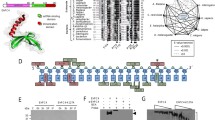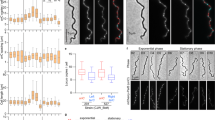Abstract
Heterogeneity of genome content is commonly observed in axenic cultures of Entamoeba histolytica. Cells with multiple nuclei and nuclei with heterogenous genome contents suggest that regulatory mechanisms that ensure alternation of DNA synthesis and mitosis are absent in this organism. Therefore, several endo-reduplicative cycles may occur without mitosis. The data also shows that unlike other endo-reduplicating organisms, E.histolytica does not undergo a precise number of endo-reduplicative cycles. We propose that irregular endo-reduplication and genome partitioning lead to heterogeneity in the genome content of E.histolytica trophozoites in their proliferative phase. The goal of future studies should be aimed at understanding the mechanisms that are involved in (a) accumulation of multiple genome contents in a single nucleus; (b) genome segregation in nuclei that contain multiple genome contents and (c) maintenance of genome fidelity in E. histolytica.



Similar content being viewed by others
References
Aktories K, Barbieri JT (2005) Bacterial cytotoxins: targeting eukaryotic switches. Nat Rev Microbiol 3:397–410
Arias-Romero LE, de Jesus Almaraz-Barrera M, Diaz-Valencia JD, Rojo- Dominguez A, Hernandez-Rivas R, Vargas M (2006) EhPAK2, a novel p21-activated kinase, is required for collagen invasion and capping in Entamoeba histolytica. Mol Biochem Parasitol 149:17–26
Banerjee S, Das S, Lohia A (2002) Eukaryotic checkpoints are absent in the cell division cycle of Entamoeba histolytica. J Biosc 27:567–572
Bell SP, Dutta A (2002) DNA replication in eukaryotic cells. Annu Rev Biochem 71:333–374
Biron D, Libros P, Sagi D, Mirelman D, Moses E (2001) Midwives assist dividing amoebae. Nature (London) 410:430
Broek D, Bartlett R, Crawford K, Nurse P (1991) Involvement of p34 cdc2 in establishing the dependency of S-phase on mitosis. Nature 349:388–393
Byers J, Eichinger D (2005) Entamoeba invadens: restriction of ploidy by colonic short chain fatty acids. Exp Parasitol 110:203–206
Cebolla A, Vinardell JM, Kiss E, Olah B, Roudier F, Kondorosi A, Kondorosi E (1999) The mitotic inhibitor ccs52 is required for endoreduplication and ploidy-dependent cell enlargement in plants. EMBO J 18:4476–4484
Dahmann C, Diffley JFX, Nasmyth K (1995) S-phase-promoting cyclindependent kinases prevent re-replication by inhibiting the transition of replication origins to a pre-replicative state. Curr Biol 5:1257–1269
Das S, Lohia A (2002) Delinking of S phase and Cytokinesis in the protozoan parasite Entamoeba histolytica. Cell Microbiol 4:55–60
Das S, Mukherjee C, Sinha P, Lohia A (2005) Constitutive association of Mcm proteins with chromatin in Entamoeba histolytica. Cell Microbiol 7: 259–267
Dastidar PG, Majumder S, Lohia A (2007) EhKlp5 is a divergent member of the kinesin 5 family that regulates genome content and microtubular assembly in Entamoeba histolytica. Cell Microbiol 9:316–328
Diffley JFX (1996) Once and only once upon a time: specifying and regulating origins of DNA replication in eukaryotic cells. Genes Dev 10:2819–2830
Dvorak JA, Kobayashi S, Alling DW, Hallahan CW (1995) Elucidation of the DNA synthetic cycle of Entamoeba spp. using flow cytometry and mathamatical modelling. J Euk Microbiol 42:610–616
Fisher O, Tov RS, Ankri S (2006) Pleiotropic phenotype in Entamoeba histolytica overexpressing DNA methyltransferase (Ehmeth). Mol Biochem Parasitol 147:48–54
Gambus A, Jones RC, Sanchez-Diaz A, Kanemaki M, van Deursen F, Edmondson RD, Labib K (2006) GINS maintains association of Cdc45 with MCM in replisome progression complexes at eukaryotic DNA replication forks. Nat Cell Biol 8:358–366
Gangopadhyay SS, Ray SS, Kennady K, Pande G, Lohia A (1997a) Heterogeneity of DNA content in axenically growing Entamoeba histolytica HM1:IMSS clone A. Mol Biochem Parasitol 90:9–20
Gangopadhyay SS, Ray SS, Sinha P, Lohia A (1997b) Unusual genome organisation in Entamoeba histolytica leads to two overlapping transcripts. Mol Biochem Parasitol 89:73–83
Ganguly A, Lohia A (2001) The cell cycle of Entamoeba invadens during vegetative growth and differentiation. Mol Biochem Parasitol 112:277–285
Ghosh SK, Samuelson J (1997) Involvement of p21racA, phosphoinositide-3-kinase, and vacuolar ATPase in phagocytosis of bacteria and erythrocytes by Entamoeba histolytica: suggestive evidence for coincidental evolution of amebic invasiveness. Infect Immun 65:4243–4249
Godbold GD, Mann BJ (2000) Cell killing by the human parasite Entamoeba histolytica is inhibited by the rho-inactivating C3 exoenzyme. Mol Biochem Parasitol 108:147–151
Godbold GD, Corbett KD, Mann BJ (2002) A Rho-like small GTPase of Entamoeba histolytica contains an unusual amino acid residue in a conserved GDP-stabilization region and is not a substrate for C3 exoenzyme. Exp Parasitol 101:107–110
Grafi G (1998) Cell cycle regulation of DNA replication:The endoreduplication perspective. Exp Cell Res 244:372–378
Gregan J, Lindner K, Brimage L, Franklin R, Namdar M, Hart EA et al (2003) Fission yeast Cdc23/Mcm10 functions after pre-replicative complex formation to promote Cdc45 chromatin binding. Mol Biol Cell 14:3876–3887
Guillen N, Boquet P, Sansonetti P (1998) The small GTP-binding protein RacG regulates uroid formation in the protozoan parasite Entamoeba histolytica. J Cell Sci 111:1729–1739
Hayles J, Fisher D, Woollard A, Nurse P (1994) Temporal order of S- phase and mitosis in fission yeast is determined by the state of the p34cdc2 mitotic B cyclin complex. Cell 78:813–822
Katiyar SK, Edlind TD (1996) Entamoeba histolytica encodes a highly divergent b-tubulin. J Eukaryot Microbiol 43:31–34
Kelman ML, Kelman Z (2003) Archaea: an archetype for replication initiation studies? Mol Microbiol 48:605–615
Labib K, Kearsey SE, Diffley JF (2001) MCM2-7 are essential components of prereplicative complexes that accumulate cooperatively in the nucleus during G1 phase and are required to establish but not maintain, the S Phase checkpoint. Mol Biol Cell 12:3658–3667
Larkins BA, Dilkes BP, Dante RA, Coelho CM, Woo YM, Liu Y (2001) Investigating the hows and whys of DNA endoreduplication. J Exp Bot 52:183–192
Loftus B, Anderson I, Davies R, Alsmark UC, Samuelson J, Amedeo P, Roncaglia P, Berriman M, Hirt RP, Mann BJ, Nozaki T, Suh B, Pop M, Duchene M, Ackers J, Tannich E, Leippe M, Hofer M, Bruchhaus I, Willhoeft U, Bhattacharya A, Chillingworth T, Churcher C, Hance Z, Harris B, Harris D, Jagels K, Moule S, Mungall K, Ormond D, Squares R, Whitehead S, Quail MA, Rabbinowitsch E., Norbertczak H, Price C, Wang Z, Guillen N, Gilchrist C, Stroup SE, Bhattacharya S, Lohia A, Foster PG, Sicheritz-Ponten T, Weber C, Singh U, Mukherjee C, El-Sayed NM, Petri WA Jr., Clark CG, Embley TM, Barrell B, Fraser CM, Hall N (2005) The genome of the protist parasite Entamoeba histolytica. Nature 433:865–868
Lohia A (2003) The cell cycle of Entamoeba histolytica. Mol Cell Biochem 253:217–222
Lohia A, Samuelson J (1993) Molecular cloning of a rho family gene of Entamoeba histolytica. Mol Biochem Parasitol 58:177–180
Lohia A, Samuelson J (1996) Heterogeneity of Entamoeba histolytica rac genes encoding p21rac homologues. Gene 173:205–208
Machida YJ, Dutta A (2007) The APC/C inhibitor, Emi1, is essential for prevention of rereplication. Genes Dev 21:184–194
Maiorano D, Lutzmann M, Mechali M (2006) MCM proteins and DNA replication. Curr Opin Cell Biol 6:130–136
Maiorano D, Cuvier O, Danis E, Mechali M (2005) MCM8 is an MCM2-7-related protein that functions as a DNA helicase during replication elongation and not initiation. Cell 11:315–328
Majumder S, Schmidt G, Lohia A, Aktories K (2006) EhRho1, a RhoA like GTPase of Entamoeba histolytica, is modified by clostridial glucosylating cytotoxins. Appl Env Microbiol 72:7842–7848
Masai H, Arai K (2002) Cdc7 kinase complex: a key regulator in the initiation of DNA replication. J Cell Physiol 190:287–296
Merchant AM, Kawasaki Y, Chen Y, Lei M, Tye BK (1997) A lesion in DNA replication initiation factor Mcm10 induces pausing of elongation forks through chromosomal replication origins in S. cerevisiae. Mol Cell Biol 17:3261–3271
Miki H, Okada Y, Hirokawa N (2005) Analysis of the kinesin superfamily: insights into structure and function. Trends Cell Biol 15:467–476
Moreno S, Nurse P (1994) Regulation of progression through the G1 phase of the cell cycle by the rum11 gene. Nature 367:236–242
Nishitani H, Lygerou Z, Nishimoto T, Nurse P (2000) The Cdt1 protein is required to license DNA for replication in yeast. Nature 404:625–628
Orozco E, Solis FJ, Dominguez J, Chavez B, Hernandez F (1988) Entamoeba histolytica: cell cycle and nuclear division. Exp Parasitol 67:85–95
Ray SS, Gangopadhyay SS, Pande G, Samuelson J, Lohia A (1997) Primary structure of Entamoeba histolytica γ-tubulin and localisation of microtubule organising centers. Mol Biochem Parasitol 90:331–336
Renault AD, Zhang XH, Alphey LS, Frenz LM, Glover DM, Saunders RD, Axton JM (2003) Giant nuclei is essential in the cell cycle transition from meiosis to mitosis. Development 130:2997–3005
Roy D, Lohia A (2004) Sequence divergence of Entamoeba histolytica tubulin is responsible for its altered tertiary structure. Biochem Biophys Res Comm 319:1010–1016
Sanchez MA, Peattie DA, Wirth D, Orozco E (1994) Cloning, genomic organization and transcription of the Entamoeba histolytica α-tubulin-encoding gene. Gene 146:239–244
Sivaprasad U, Machida, Y.J., Dutta A (2007) APC/C—the master controller of origin licensing? Cell Division 2:8 (doi:10.1186/1747-1028-2-8)
Shen PS, Lohia A, Samuelson J (1994) Molecular cloning of ras and rap genes from Entmaoeba histolytica. Mol Biochem Parasitol 64:111–120
Solis FJ, Barrios R (1991) Entamoeba histolytica: microtubule movement during mitosis. Exp Parasitol 73:276–284
Stillman B (1994) Initiation of chromosomal DNA replication in eukaryotes. Lessons from lambda. J Biol Chem 269:7047–7050
Vayssie L, Vargas M, Weber C, Guillen N (2004) Double-stranded RNA mediated homology-dependent gene silencing of gamma tubulin in the human parasite Entamoeba histolytica. Mol Biochem Parasitol 138:21–28
Vohra H, Mahajan RC, Ganguly NK (1998) Role of serum in regulating the Entamoeba histolytica cell cycle: a flow cytrometric analysis. Parasitol Res 84:835–838
Wohlschlegel JA, Dhar SK, Prokhrova T, Dutta A, Walter JC (2002) Xenopus Mcm10 binds to origins of DNA replication after Mcm2-7 and stimulates origin binding of Cdc45. Mol Cell 9:233–240
Yamaguchi S, Murakami H, Okayama H (1997) A WD repeat protein controls the cell cycle and differentiation by negatively regulating Cdc2/B-type cyclin complexes. Mol Biol Cell 8:2475–2486
Acknowledgments
This study was supported by FIRCA sub-grants from University of Virginia (GC11289-123722; Primary award number 1RO3TW007314) and Stanford University (16846170-33918-A; Primary award number 1RO3TW007421-01).
Author information
Authors and Affiliations
Corresponding author
Rights and permissions
About this article
Cite this article
Lohia, A., Mukherjee, C., Majumder, S. et al. Genome Re-duplication and Irregular Segregation Occur During the Cell Cycle of Entamoeba histolytica . Biosci Rep 27, 373–384 (2007). https://doi.org/10.1007/s10540-007-9058-8
Published:
Issue Date:
DOI: https://doi.org/10.1007/s10540-007-9058-8




